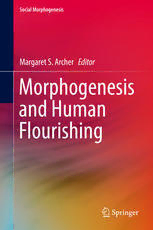
Morphogenesis and Human Flourishing PDF
Preview Morphogenesis and Human Flourishing
Social Morphogenesis Margaret S. Archer Editor Morphogenesis and Human Flourishing Morphogenesis and Human Flourishing SocialMorphogenesis SeriesEditor: MARGARETS.ARCHER CentreforSocialOntology,UniversityofWarwick,Coventry,UK Aimsandscope: To focus upon ‘social morphogenesis’ as a general process of change is very different fromexaminingitsparticularresultsoverthelastquarterofacentury.Thisseriesventures whatthegenerativemechanismsarethatproducesuchintensechangeanddiscusseshowthis differs from late modernity. Contributors examine if an intensification of morphogenesis (positive feedback that results in a change in social form) and a corresponding reduction inmorphostasis(negativefeedbackthatrestoresorreproducestheformofthesocialorder) bestcapturestheprocessinvolved. The series consists of 5 volumes derived from the Centre for Social Ontology’s annual workshops“FromModernitytoMorphogenesis”attheUniversityofLausanne,headedby MargaretArcher. Moreinformationaboutthisseriesathttp://www.springer.com/series/11959 Margaret S. Archer Editor Morphogenesis and Human Flourishing 123 Editor MargaretS.Archer CentreforSocialOntology DepartmentofSociology UniversityofWarwick Coventry,UK This volume V follows the book “Social Morphogenesis”, edited by Margaret S. Archer, whichwasthefirstbookintheseriespublishedin2013http://wwww.springer.com/social+ sciences/book/978-94-007-6127-8, the volume “Late Modernity”, edited by Margaret S. Archer, published in 2014, the volume “Generative Mechanisms Transforming the Social Order”, edited by Margaret S. Archer, published in 2015 and the volume “Morphogenesis andtheCrisisofNormativity”,editedbyMargaretS.Archer,publishedin2016. ISSN2198-1604 ISSN2198-1612 (electronic) SocialMorphogenesis ISBN978-3-319-49468-5 ISBN978-3-319-49469-2 (eBook) DOI10.1007/978-3-319-49469-2 LibraryofCongressControlNumber:2017934071 ©SpringerInternationalPublishingAG2017 Thisworkissubjecttocopyright.AllrightsarereservedbythePublisher,whetherthewholeorpartof thematerialisconcerned,specificallytherightsoftranslation,reprinting,reuseofillustrations,recitation, broadcasting,reproductiononmicrofilmsorinanyotherphysicalway,andtransmissionorinformation storageandretrieval,electronicadaptation,computersoftware,orbysimilarordissimilarmethodology nowknownorhereafterdeveloped. Theuseofgeneraldescriptivenames,registerednames,trademarks,servicemarks,etc.inthispublication doesnotimply,evenintheabsenceofaspecificstatement,thatsuchnamesareexemptfromtherelevant protectivelawsandregulationsandthereforefreeforgeneraluse. Thepublisher,theauthorsandtheeditorsaresafetoassumethattheadviceandinformationinthisbook arebelievedtobetrueandaccurateatthedateofpublication.Neitherthepublishernortheauthorsor theeditorsgiveawarranty,expressorimplied,withrespecttothematerialcontainedhereinorforany errorsoromissionsthatmayhavebeenmade.Thepublisherremainsneutralwithregardtojurisdictional claimsinpublishedmapsandinstitutionalaffiliations. Printedonacid-freepaper ThisSpringerimprintispublishedbySpringerNature TheregisteredcompanyisSpringerInternationalPublishingAG Theregisteredcompanyaddressis:Gewerbestrasse11,6330Cham,Switzerland Acknowledgement to the Independent Social Research Foundation With grateful thanks from all contributors to our book series on ‘Social Morphogenesis’ for the funding and support that we have received from the ISRF forover6years. Without this help, we could not have met in different European cities for the firstweekinJanuaryeveryyear,enjoyedourexchangesimmenselyandmanagedto produceabookayear: Archer,MargaretS.(Ed.),2013,Vol1,SocialMorphogenesis,Dordrecht,Springer. Archer, Margaret S. (Ed.), 2014, Vol 2, Late Modernity: Trajectories Towards MorphogenicSociety,Dordrecht,Springer. Archer, Margaret S., (Ed), 2015, Vol 3, Generative Mechanisms Transforming the SocialOrder,Dordrecht,Springer. Archer,MargaretS.,(Ed.),2016,Vol.4,MorphogenesisandtheCrisisofNorma- tivity,Dordrecht,Springer. Archer, Margaret S., (Ed.), 2017, Vol. 5, Morphogenesis and Human Flourishing, Dordrecht,Springer. Thankyoufromusallforsupportingourindependentresearchandthefounda- tionoftheCentreforSocialOntology. v Contents 1 Introduction:HasaMorphogenicSocietyArrived?.................... 1 MargaretS.Archer 2 Human Flourishing and Human Morphogenesis: ACriticalRealistInterpretationandCritique.......................... 29 PhilipGorski 3 SomeReservationsAboutFlourishing................................... 45 DouglasV.Porpora 4 ReflexivityinaJustMorphogenicSociety:ASociological ContributiontoPoliticalPhilosophy ..................................... 63 IsmaelAl-Amoudi 5 TheMorphogenicSocietyasSourceandChallengefor HumanFulfillment ......................................................... 93 AndreaM.Maccarini 6 DoesIntensiveMorphogenesisFosterHumanCapacities orLiabilities? ............................................................... 115 MargaretS.Archer 7 WhatDoesa‘GoodLife’MeaninaMorphogenicSociety? TheViewpointofRelationalSociology................................... 137 PierpaoloDonati 8 Flourishing or Fragmenting Amidst Variety: AndtheDigitalizationoftheArchive .................................... 163 MarkCarrigan 9 Corporations, Taxation and Responsibility: Practical and Onto-Analytical Issues for Morphogensis andEudaimonia–Aposseadesse?....................................... 185 JamieMorganandWilliamSun vii viii Contents 10 Networks and Commons: Bureaucracy, Collegiality and Organizational Morphogenesis in the Struggles toShapeCollectiveResponsibilityinNewSharingInstitutions....... 211 EmmanuelLazega 11 EudaimonicBubbles,SocialChangeandtheNHS ..................... 239 TonyLawson 12 The Will to Be: Human Flourishing and the Good InternationalSociety....................................................... 261 ColinWight 13 Creating Common Good: The Global Sustainable InformationSocietyastheGoodSociety................................. 277 WolfgangHofkirchner Chapter 1 Introduction: Has a Morphogenic Society Arrived? MargaretS.Archer Preface This is the last of five books in the series on ‘Social Morphogenesis’. So far we have explored the intensification of morphogenetic processes on a global scale from the 1980s onwards, but have refrained from claiming that these announce transition towards a new social formation replacing late modernity – the world- wide Morphogenic Society. The time has come to remove this question mark, if not definitively. Since the social sciences can rarely be predictive, because of the intrinsic openness of the social order, the interplay of multiple generative mechanismsandtheconstantinterventionofunforeseencontingencies,themostwe have offered in the previous four volumes are evaluations of whether or not there are marked tendencies consistent with the eventual emergence of a Morphogenic Society.Nevertheless,itcouldcoherentlybemaintainedthatthereareamultiplicity of social orders, ones which could now qualify as being ‘morphogenic’ and thus displayasmuchvariationasthemultipleformsofmodernityhavedonetodate. ForthosereaderswhohavenotfollowedthefiveVolumesastheyhaveappeared annually, it is reasonable for them to ask: ‘So what is the difference between Morphogenesis and Morphogenetic Society?’ The Morphogenetic/Morphostatic framework (M/M) was developed (Archer 2013a [1979], 1995) as an explanatory framework;ameansforanalyticallybreakinguptheprocesses–thatalwaysoccur over time – into tractable phases in order to explain their outcomes in relation to some change or continued stability of a social feature that is problematic to the researcher(s)inquestion.TheM/Mframeworkisnotatheory;initselfitexplains nothing, any more than does the Critical Realist ontology upon which it is based M.S.Archer((cid:2)) CentreforSocialOntology,DepartmentofSociology,UniversityofWarwick,Coventry, CV47AL,UK e-mail:[email protected] ©SpringerInternationalPublishingAG2017 1 M.S.Archer(ed.),MorphogenesisandHumanFlourishing,SocialMorphogenesis, DOI10.1007/978-3-319-49469-2_1 2 M.S.Archer (Porpora 2013, Vol 1, p. 26). To recapitulate, what we have been examining over thelastsixyears isindeed atheoreticalquestion; namely, arewegloballymoving towardsasocialformationthatcouldjustifiablybetermedaMorphogenicSociety? First and foremost, this would mean a world in which morphogenetic processes increasinglypredominatedovermorphostaticonesintermsoftheiroutcomes.The newreader’slikelyresponseisagoodone;‘Howisonetosayandonwhatbasis?’ Inearlierepochs,itwouldhavebeeneasiertopointtothefactthattransformatory mechanismswereexogenousratherthanendogenous,thatisreliantuponconquest, colonization or climatic disasters. With globalization, it is much more difficult because our one world nullifies the endogamous/exogenous distinction. What happens in one part is affected by what happens in other parts, even though it is undoubtedlythecasethatonemaybenefitattheexpenseoftheother(s).Moreover, some may rightly wish to point out that morphogenesis has been with the social order forever. They would be correct because without it there would have been no change at all, apart from those exogenously induced or introduced Thus, to answer our new reader’s hypothetical question, it is necessary to engage in some recapitulationaboutthetheoreticalpropositionsdevelopedandassessedthroughout theseries.Onlythenwillitbepossibletoappreciatehowwellthethesisstandsup toscrutinyandwherethepresentdiscussionofEudaimoniastandsinrelationtothe theoryasawhole. SummaryCharacteristicsofMorphogenicSociety No Morphogenic social formation has yet been realized that accords with the ConcreteUtopiaandtheconditionspropitioustoitsemergencearestringent,though forthefirsttimeinhistorytheirrealizationisconceivable.Forthesakeofclarityit seemsusefultore-emphasizethedistinctionbetweentheprocessofmorphogenesis andthedefiningcharacteristicsofaMorphogenicsocialformation.Morphogenesis hasalwaysbeenwithus,despitebeingaslowprocesshistoricallybecauseusually swampedbymorphostaticmechanisms.Otherwise,therewouldbenotrajectoriesof changetotracefromearlysocietiesonwardsandnoneedfortheM/Mapproach.The M/Mmodeofanalysisisnotatheory,itmerelyproffersanexplanatoryframework oranalyticaltoolkitintendedtoassisttheoriststosortouttheplethoraofdatathat surrounds every problem about why there is change or its absence at any level of the social from the micro- to the macroscopic. Conversely, the potential advent of Morphogenic society, with its origins in the late twentieth century is a theory, but what it theorises is a possibility and not the inevitability of social ‘progress’. To advance it draws upon the transcendental argument of Critical Realism (Bhaskar 1979)byaskingwhatneedstobethecaseforglobalMorphogenicsocietytobecome instantiatedforthefirsttime.Whatfollowsisthesketchiestsummaryoftherequired characteristics, ones that have been spelt out in the four previous volumes. It goes withoutsayingthattheconditionsuponwhichtherealizationofthesecharacteristics dependmaybefoundnottoobtain–atleastyet.
